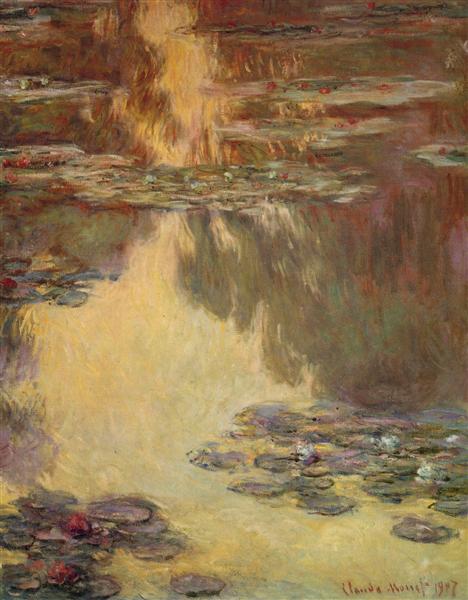Descriere
Claude Monet's Water Lilies (1907) is one of the most outstanding examples of the Impressionist master's pictorial evolution and masterfully encapsulates his obsession with light and color. This painting is part of a series of more than two hundred canvases that the artist dedicated to his garden in Giverny, a refuge where he explored the relationship between water, air and the flora that surrounded him. In this particular work, Monet presents an aquatic world that seems to dematerialize, becoming a purely sensorial feast that defies traditional perspective.
The composition of “Water Lilies” reveals a delicate balance between naturalistic representation and abstraction. At first glance, the work appears to be an endless tapestry of floating water lilies stretching across the surface of the water. Monet employs a rich palette of shades of blue, green, and white, to which he adds touches of color in a variety of lilacs and pinks, creating an impression of movement and transience. Through quick, loose brushstrokes, the artist suggests natural dynamism and the deep interaction of the environment. Against a background of calm water, the flowers emerge almost like dreamlike images, blurring the boundaries between the water surface and the sky.
In "Water Lilies", no human figures are seen; instead, Monet immerses us in an intimate landscape, where nature becomes the absolute protagonist. With this choice, Monet rethinks the idea of the traditional landscape, turning towards a more intimate and personal study of his immediate surroundings. The absence of human figures allows the viewer to immerse himself in the stillness of the garden and experience a silent reflection on the beauty of nature.
This painting is also significant within the context of the Impressionist technique. Monet, who was a pioneer of this movement, distanced himself from the rigid forms and structures of academicism, advocating a more subjective view of the world. Throughout his career, the artist focused on how light interacts with objects and their surroundings at different times of the day, and “Water Lilies” is a perfect representation of this philosophy. Light plays a crucial role in the work, not only illuminating the water lilies but also defining the overall atmosphere of this ethereal composition.
Monet's Water Lilies series is a sustained exploration of visual perception and time. By 1907, Monet had already been working on this theme for years, and each canvas reflects his growing interest in breaking down elements into their purest form. Influences from modern art trends begin to become evident in these works, which anticipate later movements such as Fauvism and Abstraction.
It is important to note that water lilies do not only represent an aesthetic trend, but also evoke feelings of peace, meditation and contemplation. Monet, at the end of his life, was experimenting with themes that captured the essence of the fleeting moment, and "Water Lilies" densifies those emotions on its surface. When observing this masterpiece, the viewer is faced with an invitation to reflect not only on Monet's artistic work, but also on his deep connection with nature that overflows in every stroke.
When studying “Water Lilies,” it is difficult not to be seduced by his way of transforming the mundane into the sublime. This work is a testament to Monet’s legacy and his enduring impact on the course of art history, as well as a reminder of the beauty that lies in the simplicity of nature itself. Ultimately, through his innovative approach and commitment to capturing the essence of a moment, Monet offers us a visual refuge that continues to inspire and resonate in the contemporary perception of art.
KUADROS ©, a famous painting on your wall.
Hand-made oil painting reproductions, with the quality of professional artists and the distinctive seal of KUADROS ©.
Painting reproduction service with satisfaction guarantee. If you are not completely satisfied with the replica of your painting, we will refund 100% of your money.

